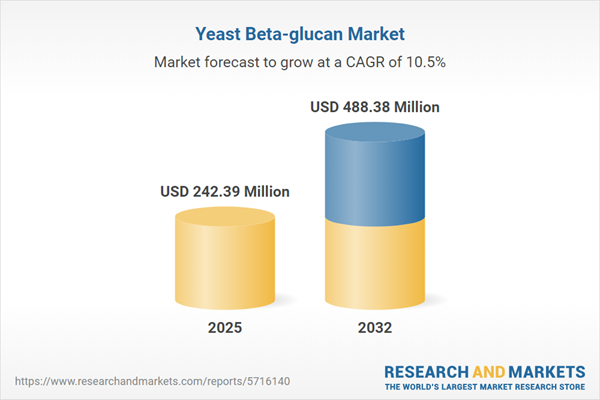Speak directly to the analyst to clarify any post sales queries you may have.
The yeast beta-glucan market is advancing rapidly, supported by a strong focus on innovative health solutions and robust supply frameworks. Senior decision-makers in this dynamic sector are evaluating new operational strategies as they seek reliable partners and differentiated product offerings.
Market Snapshot: Yeast Beta-Glucan Market
The yeast beta-glucan market is sustaining stable growth, propelled by ongoing investment and the active participation of established companies alongside emerging players. Its resilience stems from cross-industry applicability, involving food, nutraceuticals, pharmaceuticals, cosmetics, and animal feed. This diverse presence empowers various sectors to integrate yeast beta-glucan for improved product functions and market positioning. Regulatory updates and evolving safety benchmarks shape operational efficiency and product quality. Persistent research investment and strong stakeholder collaboration maintain business continuity, enabling organizations to adapt smoothly to changing regulations and consumer behaviors while minimizing market disruption.
Scope & Segmentation: Key Market Structure
- Application Areas: Organizations utilize yeast beta-glucan in animal feed, cosmetics, food and beverage, nutraceutical, and pharmaceutical products. Integration at this level delivers health-focused solutions and helps companies distinguish their portfolios amid increasing competition.
- Product Forms: Yeast beta-glucan is available as capsules, powders, and liquids. These versatile formats accommodate both B2B and B2C distribution needs, making them suitable for supplements, functional drinks, and topical applications.
- Type Variants: Offered in particulate and soluble forms, manufacturers can tailor their product claims and physical characteristics to fit targeted health outcomes or consumer preferences.
- Distribution Channels: The market leverages direct sales, online platforms, supermarkets, and pharmacies. This range of commercialization strategies extends reach and supports various channel approaches.
- End Users: Manufacturers in animal nutrition, cosmetics, food, nutraceutical, and pharmaceutical sectors drive ongoing innovation and category development by incorporating yeast beta-glucan in their product lines.
- Regional Coverage: The sector has a global footprint, stretching across the Americas, Europe, the Middle East and Africa, and Asia-Pacific. Tailoring offerings to local regulations and consumer expectations is vital for market relevance and compliance.
- Key Players Covered: Kerry Group plc, Cargill, Incorporated, Koninklijke DSM N.V., Tate & Lyle PLC, Lesaffre S.A., Lallemand Inc., Biothera, LLC, International Flavors & Fragrances Inc., Ajinomoto Co., Inc., and Beijing SinoGlucan Technology Co., Ltd. are among the leadership, infusing the marketplace with broad expertise and advancement of best practices.
Key Technologies and Regional Developments
- Advances in extraction and purification technologies are consistently improving product consistency, enabling brands to target premium segments.
- Regional strategies involve adapting product formulations to meet local compliance and cultural demands, supporting enhanced consumer trust and a stronger market presence.
- Global collaboration among value chain partners drives research and expedites commercial innovation, bolstering market responsiveness and resilience.
Key Takeaways for Senior Decision-Makers
- Expanding product lines with scientifically validated health benefits offers new avenues for differentiation, driving lasting brand advantage.
- Investing in advanced manufacturing has elevated product reliability and enabled growth into niches where quality is a critical decision factor.
- Strategic research partnerships and agile supply chain management equip organizations to respond rapidly to regulatory or demand fluctuations.
- High compliance requirements and substantiated health claims build stakeholder trust and underpin regulatory acceptance throughout value chains.
- Emphasizing sustainable sourcing meets evolving compliance criteria and reflects well on brand reputation and operational performance.
- Regional customization enhances responsiveness to local drivers and underscores organizational flexibility in adapting to new geographies.
Tariff Impact: Strategic Market Realignment
Recent adjustments to U.S. tariff frameworks prompt yeast beta-glucan producers to diversify their supply chains, reduce vulnerabilities, and cultivate firmer supplier relationships. Expanding regional networks and prioritizing local sourcing bolster operational stability. Organizations that implement adaptive contracting and flexible logistics maintain access to distribution channels and sustain market presence, even as external regulatory factors evolve.
Methodology & Data Sources
This assessment draws from direct interviews with sector authorities and careful analysis of peer-reviewed literature. The insights presented are continuously validated by industry experts to align with the needs and priorities of senior leaders making critical decisions in the yeast beta-glucan sector.
Why This Report Matters
- Senior leaders receive guidance to sharpen investment tactics, refine operational workflows, and reinforce effective market positioning in the yeast beta-glucan market.
- The report equips decision-makers to quickly address regulatory changes, navigate evolving supply chains, and seize new market opportunities.
- Its future-oriented recommendations guard long-term progress and profitability, enabling organizations to plan confidently against sector volatility.
Conclusion
Relentless focus on innovation, regulation, and technological progress positions organizations to solidify competitiveness and maximize value in the evolving yeast beta-glucan market.
Additional Product Information:
- Purchase of this report includes 1 year online access with quarterly updates.
- This report can be updated on request. Please contact our Customer Experience team using the Ask a Question widget on our website.
Table of Contents
3. Executive Summary
4. Market Overview
7. Cumulative Impact of Artificial Intelligence 2025
Companies Mentioned
The companies profiled in this Yeast Beta-glucan market report include:- Kerry Group plc
- Cargill, Incorporated
- Koninklijke DSM N.V.
- Tate & Lyle PLC
- Lesaffre S.A.
- Lallemand Inc.
- Biothera, LLC
- International Flavors & Fragrances Inc.
- Ajinomoto Co., Inc.
- Beijing SinoGlucan Technology Co., Ltd.
Table Information
| Report Attribute | Details |
|---|---|
| No. of Pages | 195 |
| Published | October 2025 |
| Forecast Period | 2025 - 2032 |
| Estimated Market Value ( USD | $ 242.39 Million |
| Forecasted Market Value ( USD | $ 488.38 Million |
| Compound Annual Growth Rate | 10.5% |
| Regions Covered | Global |
| No. of Companies Mentioned | 11 |









